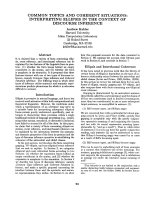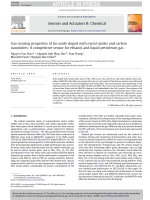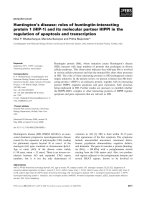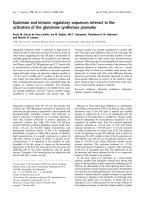Electrospun metal oxides and carbon nanofiber based materials in the application of rechargeable lithium battery
Bạn đang xem bản rút gọn của tài liệu. Xem và tải ngay bản đầy đủ của tài liệu tại đây (7.76 MB, 198 trang )
ELECTROSPUN METAL OXIDES AND CARBON
NANOFIBER-BASED MATERIALS IN THE APPLICATION OF
RECHARGEABLE LITHIUM BATTERY
WU YONGZHI
NATIONAL UNIVERSITY OF SINGAPORE
2014
ELECTROSPUN METAL OXIDES AND CARBON
NANOFIBER-BASED MATERIALS IN THE APPLICATION OF
RECHARGEABLE LITHIUM BATTERY
WU YONGZHI
(Bachelor of Science, Xi’an Jiaotong University, China)
A THESIS SUBMITTED
FOR THE DEGREE OF DOCTOR OF PHILSOPHY
NUS GRADUATE SCHOOL FOR INTEGRATIVE SCIENCES
AND ENGINEERING
NATIONAL UNIVERSITY OF SINGAPORE
2014
Declaration
I hereby declare that this thesis is my original work and it has been written by me in its
entirety. I have duly acknowledged all the sources of information which have been used in
the thesis.
This thesis has also not been submitted for any degree in any university previously.
__________________________
Wu Yongzhi
Date: ____________________
July-28-2014
i
Acknowledgements
First and foremostly, I would like to express my upmost gratitude and deepest respect to my
supervisors, Prof. Seeram Ramakrishna from the Department of Mechanical Engineering and
Prof. B. V. R. Chowdari from the Physics Department, for their wide knowledge, enthusiastic
care, tremendous support, incessant encouragement, and insightful guidance which was a great
help for me to spend four years in academic research and complete this thesis. Their foresight in
frontier science, positive attitude and hard-working spirit not only inspired and taught me
throughout my PhD study, but also would always guide me in future life.
I owe my special thanks to Dr. M. V. Reddy who provided me with valuable advices and
technical guidance during my entire research endeavor. His support and patience greatly helped
me to move forward in my research.
I would like to express my sincere thanks to Dr. Peng Shengjie for his consistent help and fruitful
discussion on my research project. And I would like to thank Dr. Sreekumaran Nair for his care
and advice at the beginning of my PhD study.
Also, I would like to extend my thanks to all my senior lab mates: Dr. Zhu Peining, Dr. Christie T.
Cherian and Dr. Zhao Xuan for their inspiring discussion and helpful suggestions; Dr. Kai Dan, Dr.
Jin Guorui, Ms. Su Yan, Ms. Jia Lin, Ms. Tian Lingling, Dr. Molamma, Dr. Gopal and Dr.
Aravindan for the memorable moment shared. I would like to all other members in our labs for
their precious friendship during my PhD study.
It is my humble duty to express my gratitude to the entire administrative staff of NUS Graduate
School of Integrative Sciences and Engineering (NGS) for their willingness to organize
ii
interesting activities and their readiness to help students. I should also express my thanks to our
lab officer Ms. Charlene Wang and Mr. Karim for their dedication in laboratory maintenance and
timely help. My thanks are also owing to Mr. Suradi and other staff from Physics workshop for
their kind support. I am also grateful to Madam Pang and Mr. Ho in Physics Department for the
support of facility usage. For support with microscopy, I would like to thank Ms. Zhang and Ms.
Yang from Materials Science and Engineering, Ms. Bo Nina and Madam Loy from NUS Centre
for BioImaging Sciences, respectively.
My special acknowledgement is owing to the financial support by way of research scholarship
and facilities from National University of Singapore.
My heartfelt thanks go to my roommates (Wu Chenyang, Zhi Ye, Xu Wang and Qin Xian), my
school mates (Zhou Yan, Zhang Sai and Hu Jue) and other dear friends, who shared enjoyable
time and countless happiness with me in Singapore.
I would like to thank my relatives for their kindness, understanding and spirited support outside
of academia, which also helped me a lot.
Finally, I am indebted to my parents for their consistent encouragement and motivation
throughout my education.
iii
Table of Contents
ACKNOWLEDGEMENTS I
TABLE OF CONTENTS III
SUMMARY VI
LIST OF FIGURES IX
LIST OF TABLES XIII
LIST OF SYMBOLS XIV
LIST OF PUBLICATIONS XVI
CHAPTER 1 INTRODUCTION 1
1.1 MOTIVATIONS 1
1.2 OBJECTIVES 4
1.3 STRATEGY & RATIONALE 5
1.4 CONTRIBUTIONS & SCOPE 7
1.5 THESIS OUTLINE 8
1.6 REFERENCES 9
CHAPTER 2 BACKGROUND AND LITERATURE REVIEW 11
2.1 BACKGROUND INFORMATION 11
2.1.1 Overview of Rechargeable Battery 11
2.1.2 Rechargeable Lithium Ion Battery 13
2.1.2.1 LIB History 13
2.1.2.2 Basic Thermodynamics 14
2.1.2.3 Working Principle of Commercial LIBs 15
2.1.2.4 Terminologies & Half Cells 16
2.1.2.5 Lithium Coin Cells 18
2.1.3 Developing Trends 19
2.2 LIB MATERIALS 20
2.2.1 Cathode Materials 21
2.2.1.1 Chalcogenides 21
2.2.1.2 Layered Oxides LiMO
2
23
2.2.1.3 Spinel Oxides LiM
2
O
4
28
2.2.1.4 Polyanionic Oxides 30
2.2.1.5 Overview for Current LIB Cathode Materials 31
2.2.2 Anode Materials 32
2.2.2.1 Carbonaceous Materials 34
2.2.2.2 Metal Oxides Based on Intercalation/De-intercalation Reaction 37
2.2.2.3 Metal Oxide Anode Based on Conversion Reaction 41
2.2.2.4 Anode Materials Based on Alloying/De-alloying Reaction 45
2.2.2.5 Anode Materials Based on Conversion and Alloying/de-alloying Reaction 47
2.2.2.6 Graphics Review for LIB Anode Materials 49
2.2.3 Electrolytes & Separators 50
2.2.3.1 Electrolytes 50
2.2.3.2 Separators 52
iv
2.3 NANOSTRUCTURES FOR PROSPECTIVE MATERIALS IN LIBS 54
2.3.1 Nanostructures at Different Dimensions 54
2.3.2 Advantageous Nano-effect for Lithium Ion Kinetics 56
2.3.3 Challenges of Nanomaterials in LIBs 57
2.3.4 Strategies of Applying Nanostructures in LIBs 58
2.4 ONE-DIMENSIONAL CARBON NANOFIBER 59
2.5 REFERENCES 61
CHAPTER 3 EXPERIMENTAL TECHNIQUES 68
3.1 ELECTROSPINNING TECHNIQUE 69
3.1.1 Direct Electrospinning 71
3.1.2 Co-Electrospinning 71
3.1.3 Hybrid Synthesis Combining Electrospinning 71
3.2 THERMAL TREATMENT 72
3.2.1 Stabilization 72
3.2.2 Carbonization 73
3.3 STRUCTURAL CHARACTERIZATION 73
3.3.1 Scanning Electronic Microscope 73
3.3.2 X-ray Diffraction Pattern 75
3.3.3 Raman Spectroscopy 76
3.3.4 Transmission Electron Microscope 77
3.3.5 Brunauer-Emmett-Teller Specific Surface area 78
3.4 COIN CELL FABRICATION 80
3.4.1 Electrode Fabrication 80
3.4.1.1 Slurry preparation 80
3.4.1.2 Coating & drying 81
3.4.1.3 Electrode cutting 81
3.4.2 Cell Assembly 81
3.5 ELECTROCHEMICAL CHARACTERIZATION 83
3.5.1 Cyclic Voltammetry 83
3.5.2 Galvanostatic Profile 84
3.5.3 Rate Capacity Measurement 85
3.5.4 Electrochemical Impedance Spectroscopy 86
3.5.5 Galvanostatic Intermittent Titration Technique 88
3.6 REFERENCES 88
CHAPTER 4 ELECTROSPUN CARBON NANOFIBERS AND THEIR LONG-TERM
ELECTROCHEMICAL BEHAVIOR 90
4.1 INTRODUCTION 91
4.2 EXPERIMENT 94
4.2.1 CNF Fabrication & Structural Characterization 94
4.2.2 Electrochemical Characterization 94
4.3 RESULTS & DISCUSSION 95
4.3.1 Morphology and Structure 95
4.3.2 Electrochemical Characterization 98
4.3.3 Electrochemical Kinetic Studies 107
4.3.4 Comparison Study 111
4.4 CONCLUSIONS 112
4.5 REFERENCES 112
v
CHAPTER 5 ELECTROSPUN NIO/RUO
2
COMPOSITE CARBON NANOFIBERS 115
5.1 INTRODUCTION 116
5.2 EXPERIMENTAL 118
5.2.1 Synthesis of NiO/RuO
2
Composite CNFs 118
5.2.2 Electrochemical Characterization 119
5.3 RESULTS & DISCUSSION 119
5.3.1 Structure and Morphology 119
5.3.2 Electrochemical performance in LIBs 124
5.3.3 Electrochemical Kinetic Study 128
5.4 CONCLUSIONS 130
5.5 REFERENCES 130
CHAPTER 6 HYBRID NANO-MAGHEMITES ON ELECTROSPUN CARBON
NANOFIBERS AS PROSPECTIVE ANODE 132
6.1 INTRODUCTION 133
6.2 EXPERIMENT 134
6.2.1 Synthesis of γ-Fe
2
O
3
NP@CNF & Characterization 134
6.2.2 Electrochemical Evaluation of γ-Fe
2
O
3
NP@CNF 135
6.3 RESULTS & DISCUSSION 136
6.4 CONCLUSIONS 151
6.5 REFERENCES 152
CHAPTER 7 ELECTROSPUN LITHIUM TITANIUM OXIDE AND THEIR
CARBON-BASED 1D NANOCOMPOSITE 155
7.1 INTRODUCTION 156
7.2 EXPERIMENT 158
7.2.1 Synthesis of LTO grains & C-LTO 158
7.2.2 Electrochemical Characterization 158
7.3 RESULTS & DISCUSSION 159
7.3.1 Morphology and Structural Characterization 159
7.3.2 Galvanostatic Cycling Studies 164
7.3.3 Electrochemical Impedance Spectroscopy 168
7.4 CONCLUSIONS 171
7.5 REFERENCES 172
CHAPTER 8 CONCLUSIONS AND FUTURE PROSPECTIVES 174
8.1 CONCLUSIONS 174
8.2 FUTURE STUDIES 177
vi
Summary
Energy storage systems have become more and more significantly important in our everyday life.
Lithium ion batteries (LIBs), the most popular example, enable the application of numerous
portable devices, such as digital cameras, smart phones, and laptops. With the advantage of high
energy efficiency, LIBs are preferred alternative to replace the conventional combustion engine
in transportation sector. In order to achieve such technological advance, novel electrode
materials as well as nano-sized conventional materials are necessary to develop LIBs of higher
volumetric and gravimetric energy capabilities. The materials should also survive fast charging
or discharging, which means they are capable to deliver high power. These key characteristics
are able to proliferate the applications of LIBs from small portable electronic devices to
battery-powered electrical vehicles (EVs). Currently, one-dimensional (1D) nanomaterials have
gained scientific attention as prospective electrode materials due to high surface area, enhanced
electronic conductivity, and large lithium accommodation space.
The goal of the present work is to develop high performing electrodes based on 1D carbon
nanofiber (CNF) and derived nanocomposites via electrospinning technique. Electrospun CNFs
are fabricated by the facile one-step direct electrospinning and afterward heat treatment. The
condition of heat treatment is responsible to develop CNFs of different fiber diameter and
surface area. As anode electrode material in LIBs, electrospun CNFs demonstrate superior
stability and higher power capability than commercial graphite due to 1 D nanostructure. More
importantly in this study, their long-term stability has been analyzed to understand their
difference during electrochemical reaction with lithium.









